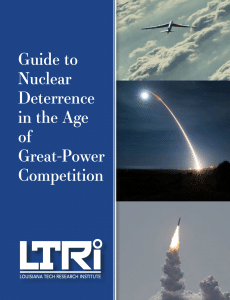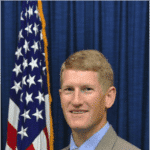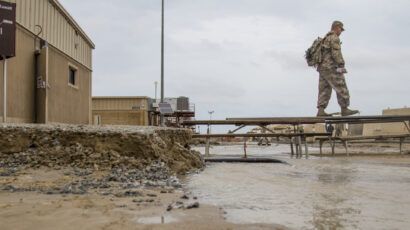“Guide to Nuclear Deterrence in the Age of Great-Power Competition”: What it actually says
By Adam Lowther | March 30, 2022
 Artist's concept of the next generation of US land-based intercontinental ballistic missile, initially known as the Ground Based Strategic Deterrent and now dubbed Sentinel. Credit: Northrop Grumman
Artist's concept of the next generation of US land-based intercontinental ballistic missile, initially known as the Ground Based Strategic Deterrent and now dubbed Sentinel. Credit: Northrop Grumman
A February 2, 2022, article, “US defense to its workforce: Nuclear war can be won,” in the Bulletin of the Atomic Scientists, dabbles in political science, history, deterrence theory, and grand strategy. The authors, university physicists Alan Kaptanoglu and Stewart Prager, offer their critique of the book, Guide to Nuclear Deterrence in the Age of Great-Power Competition. Their effort to cherry-pick incomplete quotes and mischaracterize the arguments of more than 20 leading practitioners and experts in the more than 440 pages of the book’s text deserve a rebuttal. I served as editor and a contributing author of “the guide” and speak for myself in offering the discussion below.
Kaptanoglu and Prager open their critique by quoting the November 21, 1985, Joint Soviet-United States Statement on the Summit Meeting in Geneva in which General Secretary Mikhail Gorbachev and President Ronald Reagan outlined the results of a summit that was intended, by President Reagan, to dramatically limit or eliminate all nuclear weapons. Concerning security, the statement reads:
The sides, having discussed key security issues, and conscious of the special responsibility of the USSR and the US for maintaining peace, have agreed that a nuclear war cannot be won and must never be fought. Recognizing that any conflict between the USSR and the US could have catastrophic consequences, they emphasized the importance of preventing any war between them, whether nuclear or conventional. They will not seek to achieve military superiority.

At the time of the summit, the Soviet Union fielded more than 40,000 nuclear weapons, many of which had megaton yields. The United States fielded approximately 24,000 nuclear weapons which also often carried megaton warheads. Today, however, the United States and Russia field a maximum of 1,550 operationally deployed strategic nuclear weapons—in keeping with New START.
Both nations also maintain a much smaller number of non-strategic nuclear weapons. For the United States, fewer than 200 B61 nuclear gravity bombs (non-strategic) remain in Europe, while Russia maintains between 3,000 and 6,000 non-strategic nuclear weapons, a number that is expected to increase.
As Martin Anderson and Annelise Anderson chronicle in their superb book, Reagan’s Secret War: The Untold Story of His Fight to Save the World from Nuclear Disaster, General Secretary Gorbachev and President Reagan faced the threat of a nuclear war that, if fought, would see the use of up to 65,000 nuclear weapons. Given their circumstances, neither man could have imagined that the number of deployed Russian and American nuclear weapons would decline by more than 90 percent in the immediate decades following their time in office. But it did!
It is important to understand the context in which these leaders sought arms reductions and in which President Reagan refused to negotiate away the Strategic Defense Initiative (SDI)—perhaps the disarmament community’s single most hated and lampooned program.
It is certainly ironic that two advocates of nuclear disarmament would choose a quote from the very president whose stubborn refusal to give up a space-based missile defense system was likely responsible for the failure of the Soviet Union and the United States to reach an agreement on the elimination of nuclear weapons.
False arguments. Unlike the vast majority of contributors to the guide, neither Kaptanoglu nor Prager, according to their biographies, have experience in the nuclear enterprise. While they are certainly intelligent men and accomplished in their own fields, they are novices on the topic of nuclear deterrence. Where Kaptanoglu and Prager act as arm-chair generals, the contributors to the guide were actual generals, admirals, colonels, presidential appointees, and civil servants actively engaged in planning and decision-making during and after the Cold War.
Kaptanoglu and Prager assert the guide contains “misrepresentations, omissions, and questionable policy.” With few exceptions, they inaccurately characterize the arguments made in the guide. I will take their arguments in the order and fashion they were offered.
A nuclear war can be fought and won. Kaptanoglu and Prager begin by accusing my coauthors and me of arguing that a nuclear war can be fought and won. They do this by quoting us as saying, “US strategic nuclear forces might be expected to perform the following functions … endurance throughout the various phases of a protracted (and presumably limited) nuclear war … or establish escalation dominance and nuclear-strategic superiority over any prospective opponent.” This, however, is a disingenuous effort to selectively create a quote that changes the meaning of the actual discussion.
In a section titled, “Arguments Pro and Con,” Steve Cimbala writes:
Whether current or prospective US nuclear forces are adequate depends upon their missions and tasking. US strategic nuclear forces might be expected to perform the following functions on a graduated scale of complexity: (1) guarantee assured retaliation against any aggressor; (2) provide for assured retaliation plus flexible targeting and “withholds” for follow-on attacks and interwar coercive bargaining; (3) provide for assured retaliation, flexible response, and endurance throughout the various phases of a protracted (and presumably limited) nuclear war; or (4) establish escalation dominance and nuclear-strategic superiority over any prospective opponent, including the capability to deny the attacker his objectives by deployment of highly competent missile defenses.
This is certainly not the argument for nuclear warfighting Kaptanoglu and Prager lead you to believe. Cimbala goes on to offer a critique of the view he just explained, providing the balance Kaptanoglu and Prager argue does not exist.
The reality of a possible nuclear conflict today is dramatically different than during the Cold War. Nuclear disarmament advocates’ hindsight bias makes it difficult to see that the United States is operating in a different strategic environment. There is no reliable guarantee that general deterrence will hold because nuclear powers fear thousands of intercontinental ballistic missile warheads reigning down on their cities. Those arsenals no longer exist.
Today, as Nikolai Sokov correctly explains, Russia sees the use of one or a small number of non-strategic nuclear weapons—likely low-yield—as a means to de-escalate a conflict. This leaves the United States no choice but to plan to fight and win a nuclear war, but one that is very different from the war contemplated by Mikhail Gorbachev and Ronald Reagan. The nuclear disarmament community’s thinking is stuck in an historical period that is a far cry from our present reality.
It is also important to keep in mind the task of the United States military. According to Joint Publication 1: Doctrine for the Armed Forces of the United States, “The US Armed Forces fulfill unique and crucial roles, defending the US against all adversaries while serving the Nation as a bulwark and the guarantor of its security and independence.” Within the military, it is common to say, we deter adversaries if possible and defeat them if necessary. This is the mission Congress has mandated the military to perform and one the American people expect.
As President Biden said, “We will ensure our armed forces are equipped to deter our adversaries.” He added that if deterrence fails, “The United States will never hesitate to use force when required to defend our vital national interests.”
Contrary to the insinuation of Kaptanoglu and Prager, no member of the United States military desires war, especially nuclear war, but preparing for the worst case is necessary if we seek to prevent it. Deterrence is not effective if an adversary believes the United States lacks the will to fight. In fact, it is will, not capability, that matters most to the credibility of deterrence. Thus, it is specious to insinuate some aggressive and nefarious effort on our part or the Department of Defense.
The reality of nuclear war. We are then chastised for not offering a detailed discussion of nuclear weapon effects. But this is not the point of the book. Lt. Gen. Tom Bussiere, US Strategic Command Deputy Commander, explains the purpose of the book very clearly in the forward when he writes, “To do that, we answer the simple question: why does deterrence matter to each Global Strike Airman?”
What Kaptanoglu and Prager do not understand, never having served in the Air Force nuclear enterprise, is that its men and women receive significant training and education throughout their Air Force careers regarding nuclear weapons effects. From technical training, to professional continuing education (PCE), to professional military education (PME), both enlisted and officer develop an understanding of nuclear weapon effects.
One example is poignant. It was very specifically because missile officers understood the effects of nuclear weapons and the moral dilemma that knowledge generated that the Air Force incorporated ethics training into technical training at Vandenburg Air Force Base. Firing a nuclear weapon is not an easy choice for any airman. The consequences way heavily on every man and woman who performs the nuclear mission.
Across the nuclear force, training, education, and experience are provided to pilots, missileers, maintainers, security forces, and airmen in every relevant career field. During their careers both enlisted and officer can attend courses such as Nuclear 150, 200, 300, and/or 400. They may also attend Nuclear Command, Control, and Communications (NC3) 150, 200, and/or 300, which have varying discussion on nuclear weapon effects.
Many airmen also earn the Nuclear Weapons Effects, Policy, and Proliferation (NWEPP) graduate certificate from the Air Force Institute of Technology’s (AFIT) Department of Engineering Physics. In this program, students learn to calculate weapons effects using Samuel Glasstone and Phillip Dolan’s The Effects of Nuclear Weapons—the bible of weapons effects. Equally important for the development of airmen is the Defense Nuclear Weapons School’s Theater Nuclear Operations Course (TNOC) and its Nuclear Weapons Orientation Course (NWOC), which are focused on understanding the effects of nuclear weapons and, in the case of TNOC, calculating those effects using the most advanced Defense Threat Reduction Agency software.
Officers may also have the opportunity to complete a nuclear engineering graduate degree from the Air Force Institute of Technology or a related degree from the Naval Postgraduate School (NPS). They may also attend a program at one of the professional military education schools and delve into weapon effects there.
With airmen receiving so many opportunities to develop an understanding of exactly what it means to use a nuclear weapon, there is no need for the guide to repeat what is already known.
Nuclear weapons keep the peace. Kaptanoglu and Prager follow this argument by suggesting that we overstate the role of nuclear weapons in promoting peace. They write, “Other potential contributors to the long peace—the rise of democracies, global commerce, international organizations, international law, and the hardening of national boundaries—are briefly mentioned in the guide, but only in the service of downplaying their effects.”
While this is a common argument offered by disarmament advocates, Vladimir Putin’s recent threats to use nuclear weapons offer clear support to our view. Nuclear weapons are still the primary reason nuclear armed states do not go to war and why they constrain their allies—avoiding being pulled into a nuclear conflict. Moreover, the clear failure of “economic deterrence” reminds the world that hard power still reigns supreme.
If the United States and Russia manage to avoid a nuclear conflict, it will not be because of global commerce, international organizations, international law, or any variable Steven Pinker attributes to our greater passivity. It will be the fear of nuclear war that drives both nations to deescalate.
Kaptanoglu and Prager also challenge our assessment of the Cuban Missile Crisis and the role nuclear weapons played in the agreement reached by General Secretary Nikita Khrushchev and President John Kennedy. They write, “Missing from this discussion is the now-common knowledge that Khrushchev stood down because of a secret agreement with Kennedy to remove similar missiles from Turkey. In other words, diplomacy prevailed.”
Perhaps our critics are unfamiliar with deterrence theory. It is defined by the Department of Defense Dictionary of Military and Associated Terms as “[t]he prevention of action by the credible threat of unacceptable counteraction and/or belief that the cost of action outweighs the perceived benefits.” Perhaps Dr. Strangelove explains it even better, “Deterrence is the art of producing in the mind of the enemy the fear to attack.” Thus, suggesting that nuclear weapons were not the single most important variable in resolving the Cuban Missile Crisis misses the very purpose of nuclear weapons and deterrence—avoiding conflict. The secret agreement between Khrushchev and Kennedy to remove obsolete Jupiter missiles from Turkey is an example of just how important nuclear weapons are, not the opposite.
Nuclear weapon mistakes and accidents never happen. Next, Kaptanoglu and Prager argue, “Indeed, the guide does not mention the many well-documented false-alarms and close calls of nuclear detonation from technical or human error that could have led to catastrophe.” Again, I would encourage both men to remember the purpose of the book. No single work can scratch every itch and answer every question.
I would also suggest they learned the wrong lessons from accidents involving nuclear weapons. This tired and trite argument willfully fails to accept that we have burned nuclear bombs, dropped nuclear bombs accidentally, and blown-up ICBMs—all with 1950s- and 1960s-era technology—and yet we have never had an accidental detonation. In other words, safety systems worked 100 percent of the time. That fact is indisputable.
Given the modern safety systems in our weapons, the chances of an accidental detonation are even lower today. Furthermore, our resilient Earth has experienced 2,056 above- and below-ground nuclear tests and yet it hosts 7 billion inhabitants. I have walked the test sites at both Frenchman and Yucca Flats at the Nevada Test Site, where many American nuclear tests were conducted, and toured Hiroshima and Nagasaki. The assertion that a nuclear detonation will end civilization and turn the world into a nuclear wasteland is simply not true. I have seen it with my own eyes.
Kaptanoglu and Prager suggest that the book “does not acknowledge the dangers posed by the imperfect humans who control the nuclear weapons and infrastructure.” Given the collective experience of the book’s contributors there can be no doubt that we have a deep and abiding understanding of past mistakes, but that does not mean the guide is the best place to discuss them. Airmen, for example, have Facebook pages, Signal groups, and other social media sites where they specifically discuss mistakes and how to avoid them in the future. These and other related venues within the community are far better for dissing our mistakes.
By way of example, I was a member of the Air Force team that investigated cheating on exams at Malmstrom Air Force Base in 2014. That experience gave me a great appreciation for the understanding of human fallibility that our nuclear system designers possess and their uncanny ability to build systems with multiple redundancies and checks. It is for good reason that we have never had an accidental detonation or miscalculation that led to war. Luck has nothing to do with it.
A nuclear triad is necessary. The final critique of Kaptanoglu and Prager challenges our argument that all three legs of the nuclear triad are necessary. Collectively, the contributors to the guide have explained, in detail, the unique attributes of each leg of the nuclear triad and addressed critics claims in dozens of articles over the past decade. It was for good reason that we did not rehash the errors of the disarmament logic … again.
The authors offer too many factually inaccurate assertions to dismantle each argument in a single response. Thus, let me selectively address the most egregious arguments.
First, the United States does not maintain a policy of launch on warning with the intercontinental ballistic missile force. To insist otherwise is a lie. The argument is false and belies an ignorance of strategy, policy, doctrine, and tactics, techniques, and procedures.
Second, eliminating the intercontinental ballistic missiles leg of the nuclear triad does, in fact, make it possible for an adversary to destroy the United States’ nuclear force without ever using a nuclear weapon. This is, again, a topic the guide’s contributors have written about in detail. Across our collective careers, we have conducted detailed analysis of the implications for the United States if the missile force were eliminated and none of the contributing authors has reached a point where we see the wisdom in moving to a dyad or monad.
The ICBM leg is the least expensive, most responsive, and most complicating to adversary targeting. Bombers may crash and submarines can mysteriously sink, but there is no question that an attack on an ICBM silo is an attack on American soil and worthy of reprisal.
Third, Kaptanoglu and Prager offer wildly optimistic claims about the effectiveness of a minimum deterrence strategy that has no basis in analytical rigor. Matt Kroenig’s chapter on nuclear supremacy, which synthesizes the arguments from his book, The Logic of American Nuclear Strategy, is dismissed without ever addressing his arguments. Such practice is common in their critique and unhelpful.
Conclusion
The type of sloppy critique offered by Kaptanoglu and Prager may feel good to many readers of the Bulletin of the Atomic Scientist, but it does nothing to further understanding of the nuclear deterrence debate. Frankly, the Bulletin largely serves as an echo chamber for advocates of nuclear abolition. Given the growing divide in American society and social media’s willful manipulation of our ever-shrinking world, articles like Kaptanoglu and Prager’s are not helpful because they only serve to reinforce what their audience already believes.
In 2009, Andrew Krepinevich wrote, “The world has yet to successfully ban any weapon deemed to be effective by those with the desire and the means to acquire it.” Nations seek to obtain or maintain nuclear weapons because it is in their national interests. While those interests may vary, all center around the desire for “self-determination” and sovereignty. Nuclear weapons serve as the greatest insurance policy for peace; one that can withstand failed treaties, treacherous friends, and predacious neighbors.
A world without nuclear weapons certainly feels good. However, we know the world before Hiroshima and Nagasaki. It was a world of death and destruction characterized by an average of six major-power wars each century. For over 75 years, the world has enjoyed what John Lewis Gaddis calls “the Long Peace”; a world without major-power conflict, which in turn has allowed for unprecedented prosperity.
What we need today is a vigorous and honest debate about the role nuclear weapons and deterrence play in national security. Both sides must actively engage those who do not share the same opinions—instead of retreating to their favorite echo chambers. For those of us who have dedicated our lives to service in the military and nuclear enterprise, we are more than willing to discuss and debate our positions. Let me challenge the Bulletin of the Atomic Scientist to host an active debate on its pages between those who advocate nuclear disarmament and those who advocate a modern and robust nuclear arsenal. Even if we still walk away in disagreement, we will at least understand one another.
Acknowledgements: The author would like to thank Curtis McGiffin, Mike Guillot, and Bill Murphy for their thoughtful comments, editing, and additions.
Together, we make the world safer.
The Bulletin elevates expert voices above the noise. But as an independent nonprofit organization, our operations depend on the support of readers like you. Help us continue to deliver quality journalism that holds leaders accountable. Your support of our work at any level is important. In return, we promise our coverage will be understandable, influential, vigilant, solution-oriented, and fair-minded. Together we can make a difference.
Topics: Nuclear Weapons
















If Mr. Lowther is really interested in an honest debate about the costs, risks and benefits of extended nuclear deterrence, he might want to approach his critics with a tad less vitriol and arrogance, and a bit more candor. Someone who denies that US nuclear forces historically have NOT been postured to “fight nuclear wars” (including preemptively) in order to terminate them on terms acceptable to the US (i.e. “win”) is not worth debating with.
“safety systems worked 100 percent of the time.” Then, later: “Given the modern safety systems in our weapons, the chances of an accidental detonation are even lower today.”
If a safety systems works 100% of the time, why do “chances of an accidental detonation” still exist for them to be lowered today?
This article can’t be taken seriously.